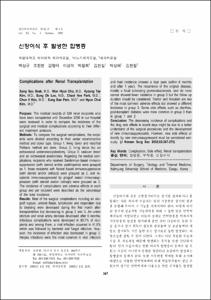신장이식 후 발생한 합병증
- Keimyung Author(s)
- Baek, Seong Kyu; Cho, Won Hyun; Kim, Hyoung Tae; Park, Choal Hee; Kim, Chun Il; Park, Sung Bae; Kim, Hyun Chul
- Journal Title
- 대한외과학회지
- Issued Date
- 2002
- Volume
- 63
- Issue
- 4
- Abstract
- Purpose: The medical records of 524 renal recipients who have been transplanted until December 2000 in our hospital were reviewed in order to compare the incidence of the surgical and medical complications according to their different treatment protocols.
Methods: To compare the surgical complications, the recipients were divided according to their ureter reconstruction method and donor type. Group 1; living donor and modified Politano method are done. Group 2; living donor but an extravesical ureteroneocystostomy. Group 3; cadaver donor and an extravesical anastomosis. Regarding the medical complications, recipients who received Sandimmun based immunosuppression (with steroid and/or azathioprine) were grouped as 1, those recipients with Neoral based immunosuppression (with steroid and/or cellcept) were grouped as 2, and recipients immunosuppressed by prograf based immunosuppression (with steroid and/or cellcept) were grouped as 3. The incidence of complications and adverse effects in each group and per recipient were described as the percentage of the total incidence.
Results: Most of the surgical complications including an allograft rupture, ureteral fistula, lymphocele and reoperation due to bleeding were developed during the first month after transplantation but decreasing in group 2 and 3. An ureter stricture and renal artery stenosis developed after 6 months. Infectious complications were developed in 60.7% of recipients and among them, a viral infection occurred in 41.9% which was followed by bacterial and fungal infection. However, the incidence of infection also decreased in group 3. Herpes infections were the most common in viral infection and their incidence showed a dual peak (within 6 months and after 1 year). The recurrence of the original disease, mostly a focal sclerosing glomerulosclerosis, and de novo cancer showed lower incidence in group 3 but the follow up duration should be considered. Tremor and hirsutism are two of the most common adverse effects but showed a different incidence in group 3. Some side effects such as diarrhea, post-transplant diabetes were more common in group 3 than in group 1 and 2.
Conclusion: The decreasing incidence of complications and the drug side effects in recent days might be due to a better understand of the surgical procedures and the development of new immunosuppressants. However, new side effects or toxicity by new immunosuppressant must be considered seriously.
- Alternative Title
- Complications after Renal Transplantation
- Publisher
- School of Medicine
- Citation
- 백성규 et al. (2002). 신장이식 후 발생한 합병증. 대한외과학회지, 63(4), 267–275.
- Type
- Article
- ISSN
- 1226-0053
- 파일 목록
-
-
Download
 oak-bbb-02960.pdf
기타 데이터 / 463.19 kB / Adobe PDF
oak-bbb-02960.pdf
기타 데이터 / 463.19 kB / Adobe PDF
-
Items in Repository are protected by copyright, with all rights reserved, unless otherwise indicated.